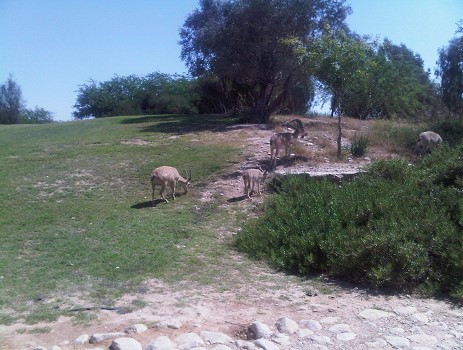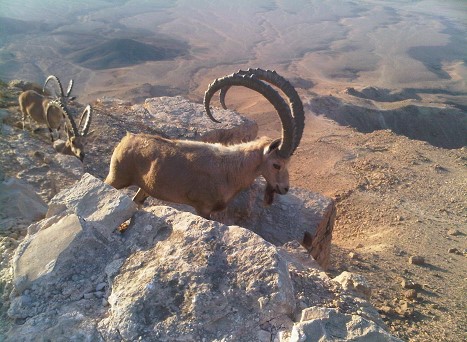|
Seeing the Ibex
When my husband and I drove south of Jerusalem, along the Dead Sea in Israel, we saw signs by the side of the road with pictures of a large mammal and the word "crossing." I thought at first it might be a deer as it had horns and a long thin head. The animal is also used as the logo for the national parks of Israel. Then to advertise some attractions for kids, an animated version of the animal wears a tee shirt and looks something like a thinner, greener Barney. I didn't like the idea of a cartoon version of the critter - I was interested in the real animal. Since there were so many signs for it to cross the road, I thought this must be a fairly common animal. But I wondered what kind of animal it was and was delighted when I found the animal identified in my tourist guidebook as an ibex, a wild mountain goat that lives in rocky, desert areas. As we drove along, I began to scan the scenery for a view of the ibex. I really wanted to see this animal; at the same time I feared hitting the ibex with the car at one of the crossings.
Animals have always been a large part of my life. I love animals whether wild or domestic - seeing them and being with them makes me happy. I am just delighted to share this world with them. But I find the attitude of many people towards animals disturbing. For example, the ibex was hunted almost to extinction during the nineteenth century when people with guns arrived in the area and began to kill animals for sport.
On our way to Eilat we stopped at an animal preserve, a place that breeds the local animals that are mentioned in the Bible such as the onager, the ostrich, and the onyx. These animals were on the brink of extinction but now exist in the preserve. Some of them have even been reintroduced into the wild. I asked if they have ibex, but they said no because the ibex now prospers in the wild and it cannot be contained by fences because of its powerful jumping ability. I pronounced the word "ib-ex," but the gate-keeper at the preserve corrected me by pronouncing it "i-bex." I enjoyed viewing the other animals and once we left the preserve, I continued to keep an eye out for the ibex. As we drove past desert mountains and empty spaces, I longed to see one in its natural habitat.
Although Masada itself was astonishing both because of the intricate nature of the buildings in such a seemingly uninhabitable place and the history associated with them, I found myself hoping as we took the cable car up to the top, that I would see an ibex jumping from rock to rock.
While we were in Eilat, we made a day trip into Petra, Jordan. Petra is an extraordinary place; once a stop along the Silk Road, it was rediscovered in the nineteenth century. Petra has gained attention recently because a scene in one of the Indiana Jones movies takes place there. As we walked along a path between two tall and solid rock formations, suddenly we saw the building known as the Treasury. The colors and the carvings and the drama make for a powerful sight.

After our stay in Eilat at the south of Israel, we drove back north through the Negev Desert. The south of Israel contains many deserts that have different kinds of dramatic terrain that seem to flow into each other - it's hard to tell where one stops and another one starts. We stayed overnight near the Ramon Crater, a large rift in the rocks that was formed geographically and not by a meteor. At the information desk I asked about the ibex and whether I would be likely to see any. A young woman replied that the ibex come to her garden and eat her shrubbery. She thinks they are a real nuisance. It reminds me of how people talk about the deer in Southampton, New York - they hate them and build fences against them and plant flowers and trees that the deer won't eat and spray their yard with deer repellant. All of this makes me sad. People move to an area because of its wildlife, then they make it impossible for the wildlife to survive. I thought from what the woman had told me that the ibex might appear more at dawn and dusk and this made sense to me as in Southampton I see deer most often in early morning and late afternoon. So we planned to be at the observation deck of the Ramon Crater early the next morning.
That afternoon we drove to the grave of David Ben Gurion as my guidebook states that his gravesite provides a beautiful view of the Negev. My husband and I parked our car and started walking along the designated path. Suddenly right beside the path I saw a herd of about twenty mammals - males with long horns and mothers protecting their children. I noticed first their beautiful medium fawn color. They all have horns. Even the females and babies have curved horns, while the males have huge horns and goatees. Their legs are their prettiest feature. Although the legs are short, they have a stripe of black up the front with a white kneecap. Their eyes are tawny and prominent, while their whole demeanor suggests sweetness combined with agility. I halted as my heart fluttered with delight and I grabbed my phone to put it in camera mode. My husband asked, "What are they?" I knew immediately: ibex. They were eating the grass that had been introduced to the area to make the gravesite more attractive. Every once in a while one would whirl his tale with nervous energy, but generally they exuded calm. They looked at us as we looked at them.

They seemed used to people and let us get within five feet of them before they would move. Then suddenly they would bound from the path towards rocky outcroppings. At that moment I felt that my trip to Israel was complete - I had seen everything that I had come there to see and anything else would be a bonus. It was somehow fitting to see the ibex near Ben Gurion's grave. Ben Gurion was the first president of Israel and a man who believed in the future of the desert area. Somehow the presence of these beautiful animals made me feel that if I were to live in Israel, it would be in the desert.
The next morning my husband and I went for a walk along the rim of the Ramon Crater. A path has been created for humans just on the edge of the crater which is a deep and unicolored gorge with a sheer drop. The path is bordered by a fence to keep people from falling into the crater and beyond the fence there are small outcroppings of rock about a foot wide before the drop. As we walked along the path, ibex darted about on the small ledge of rock just on the other side of the fence. Seeing them there made me both nervous for fear they would fall, and very happy that they were part of such a beautiful environment and that I was there to see them.

As we were heading back to New York, my husband asked me what my favorite part of the trip was and I told him that it was the walk to Ben Gurion's grave. He smiled because he knew why it was my favorite - because it was there that I had first seen the ibex. My husband laughed, "I spent thousands of dollars to take you to Israel and it turns out you would have been just as happy with a trip to the Bronx Zoo." But that wouldn't have been satisfactory to me. I loved seeing the ibex not in captivity, but wild and part of the bleak but fascinating landscape. For me it was the highlight of the trip to see an environment unlike any I have encountered before complete with the wildlife that is such a natural part of it. I was able to see animals and nature during a brief window between the time the ibex came close to extinction when men first brought guns to the area and the time when the ibex will be less and less as man populates the area more and more.
|

